Personal Pronouns in Chinese 人称代词 (rén chēng dài cí)
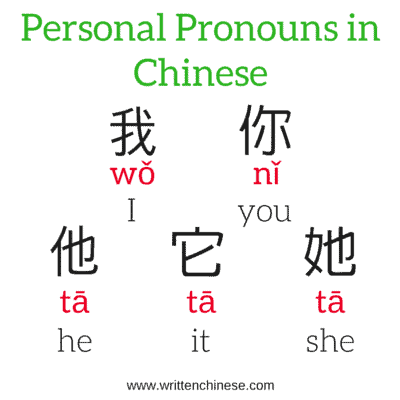
One of the first words you probably need to learn is ‘I’ 我 (wǒ). Although in Chinese, you can often get away with missing off the 我 (wǒ) ‘I’ in spoken Chinese, it is important to use it within written Chinese.
The word for ‘you’ is 你 (nǐ) and can also be used in its formal version 您 (nín), which is used to show respect to elders or superiors.
Do you know that in spoken Chinese, the words for he she and it are all the same? In a conversation with someone, it’s easy to ask the other person for clarification, but what happens in written Chinese? Luckily, personal pronouns in the written language of Mandarin Chinese have different characters.
他 (tā) – he
她 (tā) – she
它 (tā) – it
If you know a little about radicals in Chinese, you might know that usually, the meaning of the character is on the left, and the pronunciation is on the right side. Both the characters for he and she have the same radical to suggest the way it is spoken.
The left side of the character for he 他 (tā) has the person radical 人/ 亻 (rén), suggesting male origins. The character for ‘she’ 她 (tā), has the female radical 女 (nǚ) to the left of it, which indicates it is female.
Plurals
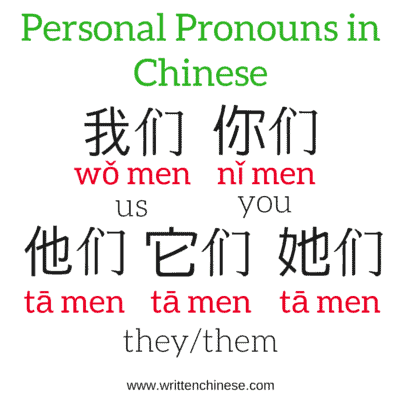
In order to pluralize personal pronouns in Chinese and create ‘we’, ‘us’ ‘they’ or ‘them’, you simply add 们 (men).
我们 (wǒ men) – us/we
你们 (nǐ men) – you (plural)
他们 (tā men) – they/them
她们 (tā men) – they/them
它们 (tā men) – they/them
他们去外面吃饭。(tā men qù wài mian chī fàn.) – They went out to eat.
Possessive 物主代词 (wù zhǔ dài cí)
Technically, the Chinese language does not have possessive pronouns, but it classed as a rule of the 的 (de) particle.
To make a pronoun ‘possessive’, you add the 的 (de) particle. Although the 的 (de) particle has many uses, at the moment it is enough to know that it makes pronouns possessive.
我的 (wǒ de) – mine
他的 (tā de) – his
她的 (tā de) – hers
If you want to say ‘my cup’, it would look like this:
我的杯子。(wǒ de bēi zi)
Me (s) cup.
In the case of alienable possession (if the object is close to the subject like a family member), the 的 (de) particle can be removed.
我妈。(wǒ mā) My mother.
Finally, to say ours, theirs or yours add the 的 (de) particle to the plural pronoun.
我们的 (wǒ men de) – ours
你们的 (nǐ men de) – yours
他们的 (tā men de) – theirs
她们的 (tā men de) – theirs
Reflexive Pronouns
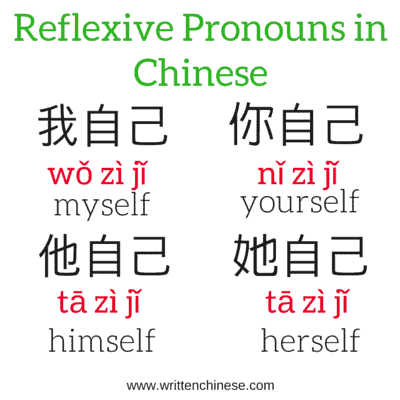
To refer to the ‘self’ in Chinese, we add the bigram 自己 (zì jǐ) to a personal pronoun:
我自己 (wǒ zì jǐ) – myself
你自己 (nǐ zì jǐ) – yourself
他自己 (tā zì jǐ) – himself
她自己 (tā zì jǐ) – herself
我们自己 (wǒ men zì jǐ) – ourselves
请用一句话介绍你自己。(qǐng yòng yī jù huà jiè shào nǐ zì jǐ.) Please introduce yourself in one sentence.
Interrogative Pronouns 疑问代词 (yí wèn dài cí)
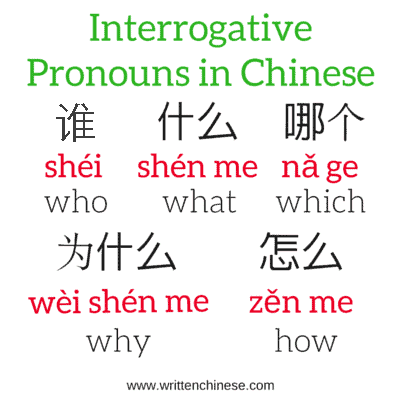
Interrogative pronouns are ‘question’ words that express an enquiry.
谁 (shéi) – Who
他是谁?(tā shì shéi) Who is he?
什么 (shén me) – What
这是什么? (zhè shì shén me) What is this?
哪个 (nǎ ge) – Which
这两个玩具,你喜欢哪一个?(zhè liǎng gè wán jù, nǐ xǐ huan nǎ yī gè)
Which of these two toys do you prefer?
为什么 (wèi shén me) – Why
这么晚了,为什么你还不回家?(zhè me wǎn le, wèi shén me nǐ hái bù huí jiā.)
It’s late. Why don’t you go home?
怎么 (zěn me) – How
这个问题怎么解决?(zhè ge wèn tí zěn me jiě jué)
How do we solve this problem?
什么时候 (shén me shí hou) – When
你什么时候来中国? (nǐ shén me shí hou lái zhōng guó.)
When will you come to China?
<p< p=””>
哪里 (nǎ lǐ) – Where
我忘记把钥匙放哪里了。(wǒ wàng jì bǎ yào shi fàng nǎ lǐ le)
I have forgotten where I put my keys.
几 (jǐ) How much/How many
我们几点见面?(wǒ men jǐ diǎn jiàn miàn)
When shall we meet?
多 (duō) – Many/Much
你花了多长时间写作业?(nǐ huā le duō cháng shí jiān xiě zuò yè.)
How much time did you spend on your homework?
Rules for Interrogative Pronouns
There are some rules regarding interrogative pronouns. Here are some examples of when to use these pronouns:
For people or things use: 谁 (shéi) – who, 什么 (shén me) – what, 哪 (nǎ) which
For place or location use: 哪儿 (nǎr) or 哪里 (nǎ lǐ)
For time use: 哪会儿 (nǎ huì er) or 多会儿 (duō huì er)
For status, actions, method or property use: 怎么 (zěn me) or 怎么样 (zěn me yàng)
For quantity use: 多 (duō), 多少 (duō shao) or 几 (jǐ).
Generally, the usage of 几 (jǐ), is almost the same as 多少 (duō shao), so they can replace each other. However, 多 (duō) can also be used to ask for levels or amounts such as 多长 (duō cháng) meaning ‘how long’ or 多大 (duō dà) meaning ‘how large’, whereas 几 (jǐ) can not be used in this way.
When interrogative pronouns are used in the way that relative pronouns are used in English, then there should be always be an adverb such as 都 (dōu) or 也 (yě). These characters are interchangeable as they have almost the same meaning. Sometimes they will be used with words such as 不管 (bù guǎn) or 无论 (wú lùn) to create emphasis.
If 都 (dōu) or 也 (yě) are removed from the sentences below, they no longer have the same meaning. The first example shows the sentence with 都 (dōu) or 也 (yě), the second shows it without.
谁也不知道他在哪儿了。(shéi yě bù zhī dao tā zài nǎr le) – No one knows where he is.
≠ 谁不知道他在哪儿。 Every knows where he is (don’t they?)
你什么都不懂。(nǐ shén me dōu bù dǒng) – You know nothing.
≠ 你什么不懂。 You know everything (don’t you?)
Take a look at the Chinese sentence type blog post to find out more about this interrogative sentence pattern.
不管怎么解释,他都不明白。(bù guǎn zěn me jiě shì, tā dōu bù míng bai.) – No matter how it has been explained, he is unable to understand.
Indefinite Pronouns
Since there are no clear cut way to translate English indefinite pronouns into their Chinese equivalents, the words we know in the English language such as ‘anything’ and ‘something’ etc are not indefinite pronouns in Chinese. In the English language, indefinite pronouns are words that include some-, any-, every- etc
Here are the some of the ways you can translate the English indefinite pronouns into Chinese:
任何事(情) / 任何东西 (rèn hé shì (qíng) / rèn hé dōng xi) – Anything
有些事(情) / 有些东西 (yǒu xiē shì (qíng) / yǒu xiē dōng xi) – Something
有人/某人 (yǒu rén/mǒu rén) – Someone
每(个)人/人人 (měi (gè) rén / rén rén – Everyone
任何人 (rèn hé rén) – Anyone
Demonstrative Pronouns 指示代词 (zhǐ shì dài cí)
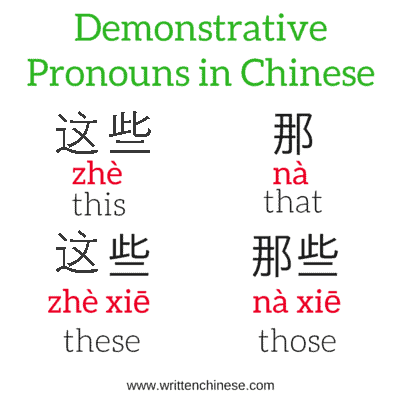
This and That
这 (zhè) and 那 (nà) can be used as both demonstratives and specifiers. A demonstrative is used to ‘point out’ an item, so that it is not confused with another object. These two characters will be used as 这 (zhè) ‘this’ and 那 (nà) ‘that’.
这样 (zhè yàng) – like this/this way
这么 (zhè me) – this much
这会儿 (zhè huìr) – at this moment
那样 (nà yàng) – that kind
那么 (nà me) – like that
那会儿 (nà huìr) – never been seen
那是我的被子。(nà shi wǒ de bèi zi.) That is my quilt.
These and Those
This 这 (zhè) and that 那 (nà) can be turned into plurals by adding the character 些 (xiē), meaning ‘few’ or ‘several’. 这些 (zhè xiē) be used to say ‘these’ and 那些 (nà xiē) for ‘those’.
Here and There
There are several ways to pronounce here and there in Chinese. In the north of China, especially in Beijing, the first 这儿 (zhèr) and 那儿 (nàr) pronunciations are common. Whereas the 这里 (zhè lǐ) and 那里 (nà li) pronunciations are used in the south.
Sometimes 这儿 (zhèr) and 那儿 (nàr) are used at the beginning of a sentence as a subject and can be, but not necessarily followed by the preposition 在 (zài). Take a look at our article about the 在 character here.
在这里有很多东西。(zài zhè lǐ yǒu hěn duō dōng xi.) There is a lot of stuff here.
If they are not the subject, then the 在 (zài) preposition must be used.
我在这里工作。(wǒ zài zhè lǐ gōng zuò) I work here.
Exercises
1. How do you say ‘myself’ in Chinese?’
2. The Chinese characters for this and that are 这 (zhè) and 那 (nà). Create mnumonics (a story or picture) to help you remember which one is which and post them in the Written Chinese Dictionary!
3. Does the Chinese language have possessive pronouns? What is used to indicate a ‘possessive’ word?
